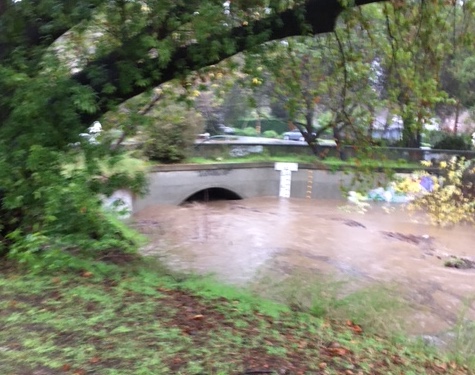
By Braden Cartwright
Daily Post Staff Writer
Residents who came to the multipurpose room at Duveneck Elementary School to hear about the city of Palo Alto’s plans for addressing flooding were feeling deja vu from sitting in the same room as they did in 1998, after the worst flood of the San Francisquito Creek on record.
“I was here 25 years ago – 25,” Alester Avenue resident Kevin Fisher said at the meeting.
“A quarter century,” another resident yelled out.
“Half a lifetime,” a third resident added.
Holly Boyd, the city’s assistant director of public works, said the plan to replace the Newell Road Bridge has a lot of moving parts, but the city is targeting next summer for construction.
“I do realize it’s been decades. This process has been a long, long process,” she said at the meeting on April 20. “I do believe we are going to get it through the finish line.” The city is planning to replace the Newell Bridge so that more water can flow through the creek during a storm, rather than breaking out into neighborhoods like it did in 1998 and on New Year’s Eve.
Once the city gets a new bridge, then the channel can be widened and the Pope-Chaucer Bridge can be replaced, protecting homes further upstream.
The later phase is being planned by the San Francisquito Creek Joint Powers Authority, which is a collection of cities and water agencies that border the creek.
“The Newell Bridge is the key part that has to happen first,” said Margaret Bruce, executive director of the creek authority.
Construction of the Newell Bridge is estimated to cost $15 million, Boyd said. Caltrans has agreed to pay $9 million, but not until 2026.
The city is asking the state to move the grant to 2024 and provide the remaining $6 million, Boyd said.
“That is flashing red in my mind,” Fisher said about the funding gap.
“I’m as confident as I can be given all the moving parts,” Boyd said.
The city also needs permission from nine property owners along Edgewood Drive to go in their backyards during construction.
The city sent them appraisals this month and is hoping to get easements by the fall, Boyd said.
The bridge is fully designed, but the city might have to change it, which could affect the price again, Boyd said.
That’s because the creek behaved differently than models projected on New Year’s Eve, and there was a lot of erosion this winter, Bruce told the crowd on Thursday.
The creek authority hired an engineering company to survey the channel, which will take a couple of months to update the models, she said.
“It wasn’t that what we knew was wrong. It’s that it was incomplete,” Bruce said.
Elizabeth Jackson, of East Palo Alto, said she was also at Duveneck after the flood in 1998, and the same parking garage on Woodland Avenue was flooded on New Year’s Eve, which was the second heaviest creek flow on record.
Residents were disappointed to hear Bruce say they would probably have to keep paying flood insurance, even after the flood control projects are finished.
FEMA requires flood insurance for properties that are at a 1% risk of flooding each year, or what is known as a 100-year flood.
To reach that standard, the creek authority would need to extend the channel into private property, raise the bridges and build concrete walls along the length of the creek, Bruce said.
That kind of project was rejected during a review under the California Environmental Quality Act.
FEMA’s flood zones are also getting bigger because climate change is leading to more rain, Bruce said.
“The goal posts are moving,” she said.
Stanford has proposed one long-term project that offers some hope for moving properties out of the flood zone, Bruce said.
The university is planning to put a hole in the Searsville Dam to wash silt out of the reservoir, allowing it to hold more water during a storm.
The creek authority supports the project but has concerns, including how the release of silt impacts water behavior downstream, Bruce said.
“We need each other’s projects to succeed,” she said.

I doubt the city will fix this in the next 25 years. That’s because replacing these bridges will mean more traffic, and the people there will never let that happen, They’d sooner have the bridges (Newell and Pope Chaucer) and not replace them.
I think you mean they’d rather have no bridges.
Looking at their plans, I think they have more than a year’s worth of work to do before they can start construction. I wish they’d be honest about this rather than teasing people, saying a solution is near.